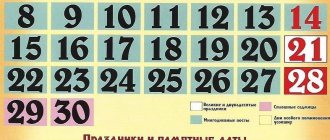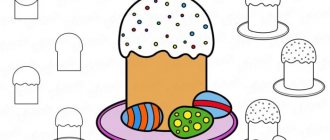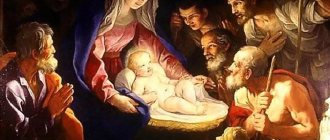Since Easter falls on different dates all the time, many people have a question: how do they calculate when Easter will be, on what day, and why is it celebrated at different times? For example, in 2021 Orthodox Christians will celebrate the main celebration on May 2, and in 2022 on April 24.
The explanation is very simple: Easter is always celebrated on the first Sunday that falls after the first spring full moon. Illustrative examples of how to calculate the date of Easter, how to calculate when Easter Sunday comes, and from what day the date of the main holiday of Christians is calculated are presented in the article.
How Orthodox Easter is considered: rules and examples
To determine how Easter day is counted, you need to proceed from 2 basic rules:
Although calendar spring begins on March 1, Christians begin counting from March 20. This is the day of the vernal equinox, when the lengths of day and night are equal to the nearest minute (12 hours each). Moreover, on the same day the so-called astronomical spring begins - already on the next day the length of the day becomes longer than the length of the night. This will continue until the autumn equinox (September 22-23). Starting from this day you need to wait for the first full moon. It is called the first of spring, as well as Easter. As soon as the Moon becomes full, Easter will be celebrated next Sunday.
However, another question arises here. In 2021, the first full moon will take place on March 21, and Easter will be celebrated only on April 28. What's the matter?
Here you need to keep in mind that the secular country of Russia lives according to the Gregorian calendar (new style), like most other countries in the world. However, the Orthodox Church still calculates all days according to the Julian calendar (old style), i.e. 13 later.
A classic example is the same old New Year, which, as we know, is celebrated on the night of January 13-14.
Thus, from this point of view it is very simple to understand how Easter is calculated among the Orthodox :
We proceed from the fact that spring begins on April 2 (according to the old style, i.e. according to the Julian calendar, which is still used in Orthodoxy). We determine the full moon closest to this date according to the Lunar calendar. Next Sunday is Orthodox Easter.
When is Easter for Catholics?
In 1583, Pope Gregory XIII introduced a new Paschal in the Roman Catholic Church, called the Gregorian. Due to the change in Easter, the entire calendar also changed. As a result of the transition to more precise astronomical dates, Catholic Easter is often celebrated earlier than Jewish Easter or on the same day, and precedes Orthodox Easter in some years by more than a month. The discrepancy between the dates of Orthodox Easter and Catholic Easter is caused by the difference in the date of church full moons, and the difference between solar calendars - 13 days in the 21st century. Western Easter in 45% of cases is a week earlier than Orthodox, in 30% of cases it coincides, 5% is a difference of 4 weeks, and 20% is a difference of 5 weeks (more than the lunar cycle). There is no difference of 2-3 weeks. Catholic Easter can be calculated using the following algorithm: 1. G = (Y mod 19) + 1 (G is the so-called “golden number in the Metonic” cycle - the 19-year full moon cycle) 2. C = (Y/100) + 1 ( if Y is not a multiple of 100, then C is the number of the century) 3. X = 3*C/4 – 12 (adjustment for the fact that three of the four years that are multiples of 100 are not leap years) 4. Z = (8*C + 5)/ 25 – 5 (synchronization with the lunar orbit, the year is not a multiple of the lunar month) 5. D = 5*Y/4 – X – 10 (in March, day ?D mod 7 will be Sunday) 6. E = (10*G + 20 + Z - X) mod 30 (epact - indicates the day of the full moon) 7. IF (E = 24) OR (E = 25 AND G > 11) THEN increase E by 1 8. N = 44 - E (Nth March - day of the calendar full moon) 9. IF N 10. N = N + 7 - (D + N) mod 7 11.IF N > 31 THEN the date of Easter (N ? 31) April ELSE the date of Easter N March Photo - Lori's photo bank
How to determine the date of Easter
In addition to the above method, there is also an arithmetic one. It consists of simple operations and numbers and was invented by Gauss, a German mathematician and scientist in the 19th century.
Easter is celebrated on the first Sunday after the spring full moon
First you need to divide the number of the desired year by 19 and select the remainder. The same thing needs to be done two more times, but with the numbers 4 and seven. We have 3 remainders after each action. Now we multiply the first remainder by 19 and divide by 30, find the remainder. We multiply the second remainder by 2, the third by 4, the fourth by 6. We add the resulting data and add 6, divide by 7. We find the remainder again.
If the sum of the fourth and fifth balances is less than 9, then the month of celebration is March. Now all that remains is to determine the date. Let's add the fourth and fifth remainders and add 22. The resulting number is the date of the celebration.
If the sum of the fourth and fifth remainders is greater than 9, then the month of celebration is April. To determine the date, add the fourth and fifth remainders and subtract 9. The resulting number is the date of the celebration. This method will be relevant until 2101. Later, due to a break in calendars, it will be slightly changed.
Easter chants
Stichera at the beginning of Matins
Thy Resurrection, O Christ the Savior, the angels sing in heaven, and grant us on earth to glorify Thee with a pure heart.
Troparion of the Resurrection of Christ
Christ rose from the dead, trampling down death by death, and giving life to those in the tombs.
Kontakion of the Resurrection of Christ
Even though you descended into the grave, Immortal, you destroyed the power of hell and rose again as the Victor, Christ God, telling the myrrh-bearing women: Rejoice! And grant peace to your apostles, grant resurrection to the fallen.
Sunday Carol
Having seen the Resurrection of Christ, let us worship the Holy Lord Jesus, the only sinless one, we worship Your Cross, O Christ, and we sing and glorify Your holy Resurrection: for You are our God, do we know no other to You, we call Your name. Come, all faithful, let us worship the Holy Resurrection of Christ: behold, through the Cross joy has come to the whole world. Always blessing the Lord, we sing His Resurrection: having endured the crucifixion, destroy death by death.
Easter in 2021 is April 28!
The Resurrection of Christ (Easter) is the most important Christian holiday, established in remembrance of the Resurrection of Jesus Christ from the dead. The Charter of the church service depends on the date of Easter (from this day the countdown of the “pillars” of osmoglasia begins), and the end of the longest and strictest Lent (breaking the fast) and many other Orthodox holidays. Even for people far from religion, Holy Easter is associated with a nightly solemn service, a procession of the cross and Easter cakes, colored eggs and the ringing of bells. What is the spiritual meaning of Easter and what are its traditions? — More on this in the article below.
Content
Easter of Christ. How many days are celebrated? Event of Easter: excerpt from the Gospel Celebration of Easter in history. Why is Sunday called Sunday?What date is Easter for the Orthodox?How to calculate the date of Easter?Orthodox Easter serviceTraditions of celebrating Easter among the Old BelieversThe Resurrection of Christ. IconsTemples of the Resurrection of ChristOld Believer Churches of the Resurrection of ChristChristian Easter and Passover among the Jews (Jewish Passover) in 2021New Paschalists and their teachings
Lent
Easter is preceded by Great Lent - the strictest and longest of all Orthodox fasts. When does Lent begin? It depends on the date on which Easter falls in the current year. Lent always lasts 48 days: 40 days of Lent proper, called Lent, and 8 days of Holy Week, starting from Lazarus Saturday until Great Saturday on the eve of Easter. Therefore, the beginning of Lent can be easily determined by counting 7 weeks from the date of Easter. The significance of Lent lies not only in the strict rules of abstinence from food (the consumption of only plant products is prescribed, fish is allowed only twice - on the Annunciation and on Palm Sunday), and avoidance of various entertainments and amusements, but also in a very deep liturgical structure in its content . The services of Lent are completely special, unlike anything else. Each Sunday is dedicated to its own special theme, and together they incite believers to deep humility before God and repentance of their sins. Read more about the post here »»
Why is Easter celebrated on different dates?
In the Orthodox religion, there are both transitory holidays, that is, the date of celebration, which does not have a clearly established day, and enduring ones, namely those celebrations that take place on the same day every year.
One of the main moving holidays, on the day of which almost the majority of the liturgical yearly cycle depends, is Easter. As a rule, the days of celebrating Pentecost, the Feast of the Entry of the Lord into Jerusalem, the Ascension, the beginning of Lent and more depend on it. On this day, Christians bake Easter cakes, paint eggs, and clean the house.
What is more important: the death of Christ or the resurrection?
But enough about the sad things, the goal of those who have found true freedom in Christ is not to blame these “captives,” but to help them. How can this be done on this day?
As always, you should try to engage their minds by asking simple questions:
— You've probably heard that Easter is coming soon? What do you think is more important: that Jesus died or that he rose again?
- Probably resurrected...
- What do you think atones for our sins, the fact that he died, or the fact that he was resurrected?
- Probably because he died...
- So it turns out that what is more important: the fact that Jesus died, or the fact that he was resurrected?
The last question is rhetorical, since even a child can draw the right conclusion. If this is not enough, then you can read this scripture:
- For God so loved the world that he gave his only begotten Son, that whoever believes in him should not perish, but have eternal life. (John 3:16)
Notice that God's love is that he GAVE his son to die, and did not RESURRECT him. Where is it easier?
How Easter is calculated for each year: Gauss's formula
And now a few words about how to calculate Easter yourself. In general, you may not even know when exactly the full moon occurs. In this case, the date can be determined for any year – at least 10 years in advance.
For this, the so-called Gauss formula is used. At first glance, it seems quite complicated, although in fact, to understand it, it is enough to know only simple arithmetic.
So, for the calculation we need to determine 5 values - let's call them A, B, C, D and E. We also need the year in which we determine the day of celebration. Let's take 2021 as an example.
The algorithm for how Easter day is considered in Orthodoxy (i.e. according to the old calendar) is as follows:
First we divide 2021 by 19. We get the remainder 5 - this is the value A. We divide 2021 by 4. We get the remainder 3 - this is the value B. We divide 2021 by 7. We get the remainder 3 - this is the value C. Now we perform the following actions: (19*A+ 15)/30. From this division we also need to take only the remainder - this is 20 (the value of D). Now we perform the following actions: (2B+4C+6D+6)/7. Again we take the remainder of the division - in this case it is equal to 4 (the value of E).
Now you need to choose one of these formulas:
22+D+E (this is how the date in March is determined). D+E-9 (this is how the date in April is determined).
To understand which formula to choose, let’s do calculations for each of them: in the first case, it turns out 22 + 20 + 4 = 46. This number will not work, because there are no more than 31 days in 1 month. So, we take the second formula: 20 + 4-9 = 15. Now we add 13, since we need to take into account the difference between the old and new style. We get April 28 - it is on this day that Easter will be celebrated in 2021.
Easter calendar for 2020-2030
In order not to waste time on calculations, you can look at the Easter calendar for 2020-2030.
| Year | Catholic | Orthodox |
| 2020 | 12.04 | 19.04 |
| 2021 | 4.04 | 2.05 |
| 2022 | 17.04 | 24.04 |
| 2023 | 9.04 | 16.04 |
| 2024 | 31.03 | 5.05 |
| 2025 | 20.04 | 20.04 |
| 2026 | 5.04 | 12.04 |
| 2027 | 28.03 | 5.05 |
| 2028 | 16.04 | 16.04 |
| 2029 | 1.04 | 8.04 |
| 2030 | 21.04 | 28.04 |
Regardless of which denomination the parishioner belongs to - Catholic or Orthodox, the spiritual meaning of the holiday remains unchanged. For believers, the resurrection of the Son of God marks victory over death and hope for eternal life.
How is the date of Easter calculated?
Previously, in Russia, even uneducated peasants could easily determine the date of Easter. They simply counted down 48 days from the beginning of Lent. Almost everyone followed it then, so the date of Easter was known. This was perhaps the only way. Since few people are fasting now, you can use another method. Here is his algorithm:
Determine the day of the vernal equinox. Find out when the first full moon occurs after it. The first Sunday after the full moon is the day of Holy Easter.
You will notice that the method is quite easy. It does not require any knowledge. All data can be provided by the Internet.
Scientists have determined that according to the Gregorian calendar, the earliest Holy Easter was April 4, and the latest was May 8. Orthodox and Catholic Easter will never go beyond this range.
Easter among the first Christians
In the Christian church, Easter has been celebrated since the first centuries, but due to local traditions, calendar peculiarities and calculations in communities of different cities, the days of Easter celebrations did not coincide. Therefore, at the First Ecumenical Council in 325, it was decided to adopt a uniform method for determining the date of Easter for the entire Christian world. It was then decided that Christians should not adhere to the custom of the Jews in determining the day of this most holy celebration. At the Council it was forbidden to celebrate Easter “before the vernal equinox with the Jews.”
Who can save us from eternal death?
All of us, people of planet Earth, are like this patient. We all get sick, grow old and die. And all our medicines have only a temporary healing effect.
They cannot save us from certain death and give us eternal life. And the disease that we all suffer from is simply called sin.
But, as in this example, a new medicine that can save us from eternal death has already been prescribed by our loving doctor - God.
- …The wages of sin is death, but the gift of God is eternal life through Christ Jesus our Lord. (Rom.6:23)
Everything would seem simple and clear. Life and death on the scales of our existence. Sin is death, the heavy burden of all people. But there is a new medicine that can deliver us from death - Jesus. But for many, one thing is not clear: how to take this medicine?
In our world, billions of people consider themselves Christians. Many of them are sure that by calling themselves that, they have already secured a place for themselves in eternal life.
But you must admit, if you have a high temperature, then repeating out loud many times: “Aspirin, aspirin, aspirin, aspirin...” will not bring down the temperature.
And to recover from a serious illness requires considerable effort, and not just self-hypnosis. So how do you take this “medicine of life”?
- God loves the world so much that he gave his only begotten Son so that everyone who exercises faith in him will not perish but have eternal life. (John 3:16)
From these words it is clear that eternal life directly depends on whether we exercise faith in Christ or not. But in what sense should we exercise faith in him?
What does it mean to exercise faith in Christ?
Today, even many atheists believe that Jesus is a real historical figure. And Muslims even believe that he was a great prophet. So what, this will help them get eternal life? Of course not. Even just “accepting Jesus in your heart” is also not enough. The Apostle Paul sheds light on this issue:
- He did not, like those high priests, need to offer sacrifices daily - first for his sins, and then for the sins of the people (he did this once and for all, sacrificing himself), (Heb. 7:27)
Here is the key to the solution - the atoning sacrifice of Christ. In the past, Jews were required to sacrifice animals to atone for their sins.
This was the medicine that, although it helped partly, did not completely solve the problem. The sacrifice of Jesus is a new medicine that can work a miracle and give a person eternal life.
What, you can't believe it? But that's the whole point. It is the belief that the death of Jesus can cure death that is what is needed for eternal salvation.
But most people are like a sick person who, having received life-saving medicine, simply throws it away. He doesn't believe it CAN help him.
He can't believe it because he doesn't understand HOW it can help him. He doesn't want to believe because he doesn't TRUST the doctor who gave him this medicine. He doesn't believe the doctor because he KNOWS him BAD.
One day I happened to meet an elderly Baptist. He immediately put me down, saying that he had been studying the Bible for 30 years, and I couldn’t tell him anything new.
Well, okay, I thought, if you are so self-sufficient, then talk some sense into me, you idiot. I asked him a childish question:
- Tell me, why did Jesus die? “In order to redeem us from our sins,” he answered proudly, with knowledge of the matter. - But we are still sinners, right? - I asked him. “So that we have eternal life,” he offered the second, memorized option. “But no one lives forever,” I retorted, “right?”
Then I didn’t have a computer yet, but now I can say what happened to him then - his Windows 98 froze. With that we said goodbye.
This incident clearly shows that even many who read the Bible have no idea how this life medicine works, how to take it and at what time.
Why did Christ die?
Since we are already talking about the resurrection of Christ, let’s bring this topic to its logical conclusion, and for this we will go back to the beginning. Before Jesus could be resurrected, he had to die. For what?
A good example
One day a sick man came to see a doctor. He really needed the help of a doctor, as his condition was serious. The doctor prescribed this patient a good new medicine that was supposed to rid him of the disease forever. That's how it would have happened...
But our patient did not even bother to read the prescription carefully, but bought at the nearest pharmacy the medicine that he had been using for a long time before.
It helped him only partly and could not completely overcome his illness. Soon this man died...
Who is to blame for his death? Funny question, right? Well, of course he himself, since he did not follow the doctor’s clear instructions.











